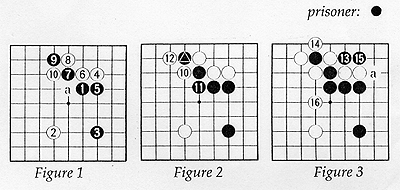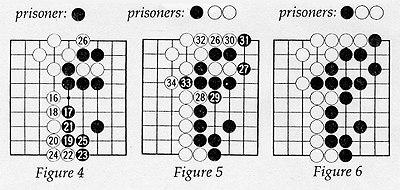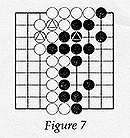The development of go in Japan
In the 12th century, the warrior class supplanted the aristocracy as the effective rulers of Japan, and until the 17th century the country was engulfed in almost continual warfare. During this period, go was highly regarded by the warrior generals, some of whom believed that the study of its tactics and strategies was good moral and intellectual training for the operations of armies in the field. The three greatest Japanese warlords of the late 16th and early 17th centuries-Oda Nobunaga, Toyotomi Hideyoshi and Tokugawa Ieyasu-were devotees of go, and they all employed go teachers for themselves and their officers.In 1588, Nobunaga's successor, Toyotomi Hideyoshi, organized a large-scale competition to systematize the rankings of go players. Nikkai, a high-ranking Buddhist monk, who was Nobunaga's go teacher, won this competition and Hideyoshi decreed that from then on all other players should take black or a larger handicap from him. Nikkai was also awarded a stipend which began the government patronage that enabled go to flourish in Japan.
At the beginning of the 17th century, four go houses were established: the Honinbo (of which Nikkai became the head, changing his name to Honinbo Sansa), Inoue, Yasui and Hayashi. These houses competed in the search for the most talented players and devoted great effort to the study and development of go theory and technique in order to surpass each other. Around the same time, in 1603, Tokugawa Ieyasu united Japan under the Tokugawa Shogunate. His government awarded stipends to the four go houses, established the office of Godokoro, held by Honinbo Sansa until his death in 1623, and instituted the annual castle games played in the presence of the shogun.
The Godokoro was the top go post in the Edo-era go world. The holder of this office was the shogun's official go instructor. He also controlled promotions and the issuing of diplomas. In addition, the Godokoro decided pairings for the annual castle games and was responsible for all ceremonies connected with go, such as games played before the emperor and games with foreigners. Only the top player could become Godokoro, which meant that he would also be promoted to the ultimate rank of Meijin (master player). It is said that sometime in 1578 while Nobunaga was watching Nikkai play, he was so impressed with the latter's skill that he cried out "Meijin!'' This is apparently the origin of the term. It continues today as the name of one of the top three professional go titles.
Capturing stones in a game
When you capture stones, you put them in your prisoner pile; then, at the end of the game, you place them inside your opponent's territory, thereby reducing its size. The following game on a 9x9 board illustrates this.

After Black 3 in Figure 1, White plays inside Black's sphere of influence with 4. White 10 ataris (threatens to capture) the black stone at 7, so if Black doesn't connect at "a," White will play there and capture it.
Black connects at 11 in Figure 2, but White ataris the marked black stone with 12. This stone cannot be rescued, so Black sacrifices it and counter-ataris with 13 in Figure 3. White captures with 14 and puts this stone into his prisoner pile. Next, Black ataris two white stones with 15. That is, he can capture them by playing at "a."

White secures the area on the left side with 16 in Figure 4, after which Black expands his right side with 17, 19, and 21. The sequence from White 22 to Black 25 are basic endgame moves.
White 26 forces Black to capture two white stones with 27 in Figure 5. Black puts them into his prisoner pile. White 28 and 30 each reduce Black's territory by one point. Black 31 ataris the two white stones at 26 and 30, so White must connect at 32. Finally, Black 33 reduces White's territory on the left by one point. The game ends when White blocks with 34. Figure 6 shows the board at the end of the game. White has one black stone in his prisoner pile, while Black has two white ones.
 In Figure 7, each side places his prisoners in his opponent's territory. White places his one black prisoner (the marked black stone) inside Black's territory, and Black places his two white prisoners (the two marked white stones) inside White's territory.
In Figure 7, each side places his prisoners in his opponent's territory. White places his one black prisoner (the marked black stone) inside Black's territory, and Black places his two white prisoners (the two marked white stones) inside White's territory.
Calculation of the size of the territories can now be made: Black: 23 points; White: 24 points. White wins by 1 point.
